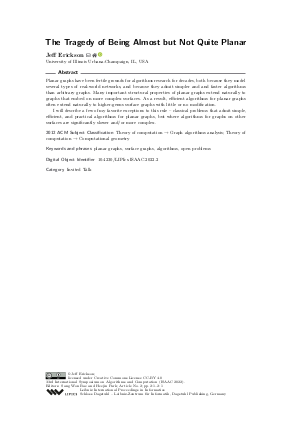The Tragedy of Being Almost but Not Quite Planar (Invited Talk)
Author
Jeff Erickson 
-
Part of:
Volume:
33rd International Symposium on Algorithms and Computation (ISAAC 2022)
Part of: Series: Leibniz International Proceedings in Informatics (LIPIcs)
Part of: Conference: International Symposium on Algorithms and Computation (ISAAC) - License:
 Creative Commons Attribution 4.0 International license
Creative Commons Attribution 4.0 International license
- Publication Date: 2022-12-14
File

PDF
LIPIcs.ISAAC.2022.2.pdf
- Filesize: 326 kB
- 1 pages
Document Identifiers
Subject Classification
ACM Subject Classification
- Theory of computation → Graph algorithms analysis
- Theory of computation → Computational geometry
Keywords
- planar graphs
- surface graphs
- algorithms
- open problems
Metrics
- Access Statistics
-
Total Accesses (updated on a weekly basis)
0Document
0Metadata
Abstract
Planar graphs have been fertile grounds for algorithms research for decades, both because they model several types of real-world networks, and because they admit simpler and and faster algorithms than arbitrary graphs. Many important structural properties of planar graphs extend naturally to graphs that embed on more complex surfaces. As a result, efficient algorithms for planar graphs often extend naturally to higher-genus surface graphs with little or no modification. I will describe a few of my favorite exceptions to this rule - classical problems that admit simple, efficient, and practical algorithms for planar graphs, but where algorithms for graphs on other surfaces are significantly slower and/or more complex.
Cite As Get BibTex
Jeff Erickson. The Tragedy of Being Almost but Not Quite Planar (Invited Talk). In 33rd International Symposium on Algorithms and Computation (ISAAC 2022). Leibniz International Proceedings in Informatics (LIPIcs), Volume 248, p. 2:1, Schloss Dagstuhl – Leibniz-Zentrum für Informatik (2022)
https://doi.org/10.4230/LIPIcs.ISAAC.2022.2
BibTex
@InProceedings{erickson:LIPIcs.ISAAC.2022.2,
author = {Erickson, Jeff},
title = {{The Tragedy of Being Almost but Not Quite Planar}},
booktitle = {33rd International Symposium on Algorithms and Computation (ISAAC 2022)},
pages = {2:1--2:1},
series = {Leibniz International Proceedings in Informatics (LIPIcs)},
ISBN = {978-3-95977-258-7},
ISSN = {1868-8969},
year = {2022},
volume = {248},
editor = {Bae, Sang Won and Park, Heejin},
publisher = {Schloss Dagstuhl -- Leibniz-Zentrum f{\"u}r Informatik},
address = {Dagstuhl, Germany},
URL = {https://drops.dagstuhl.de/entities/document/10.4230/LIPIcs.ISAAC.2022.2},
URN = {urn:nbn:de:0030-drops-172875},
doi = {10.4230/LIPIcs.ISAAC.2022.2},
annote = {Keywords: planar graphs, surface graphs, algorithms, open problems}
}
